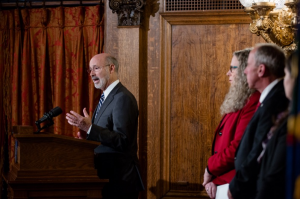
Gov. Tom Wolf and other sate officials announce the disaster declaration Wednesday afternoon.
Credit: PA Internet News Service
Officials will set up a command center and unveil unprecedented new steps that will be put in place following Gov. Tom Wolf’s opioid crisis disaster declaration.
Wolf said during a Wednesday afternoon press conference in Harrisburg that the declaration is a first-of-its-kind for a public health emergency in the state, but it is not a”silver bullet” that will stop the crisis.
“While we have made progress in combating the heroin and opioid abuse crisis and drastically expanded Pennsylvania’s response, we are still losing far too many Pennsylvanians,” Wolf said. “I am taking this step to protect Pennsylvanians from this looming public health crisis, and I am using every tool at my disposal to get those suffering from substance use disorders into treatment, save more lives, and improve response coordination.”
The disaster declaration will last for 90 days and focuses on 13 key initiatives to the ramp up efforts to fight the opioid epidemic.
The disaster declaration was issued after reviewing the impacts of the opioid crisis and talking to families of those impacted, Wolf told reporters.
“I don’t take this action lightly. We know that this crisis has taken too many lives, broken far too many families, desolated far too many communities and has gone on far too long,” he said.
Federal officials said that there were 4,362 overdose deaths statewide in 2016. Bucks County officials reported 168 drug-related deaths in the same year. Those numbers were expected to rise once final 2017 figures are released.
The disaster declaration will expand access to the prescription drug monitoring program, allow the Department of Health to collect data for overdoses and neonatal abstinence syndrome, authorize an emergency purchase authorization to expand the drug and alcohol hotline (1-800-662-HELP), permit emergency responders to leave behind additional doses of naloxone at calls, expand access to naloxone for at-risk individuals once they leave treatment of prison, expand a pilot program to cut down on lapsing at Wernersville Community Corrections Center, waive the face-to-face physician requirement for Narcotic Treatment Program admissions, expand access to medication-assisted treatment, waive annual licensing requirements for high-performing drug and alcohol treatment facilities, hold the fee for birth certificates for vulnerable populations so they can access treatment quicker and waive separate licensing requirements for hospitals and emergency departments to expand access to drug and alcohol treatment.
The Opioid Operational Command Center at the Pennsylvania Emergency Management Agency will foster better coordination among state police, corrections officials, Commission on Crime and Delinquency, Department of Health and Department of Drug and Alcohol Programs.
“I routinely challenge all commonwealth agencies to think innovatively about how they continue to address the opioid epidemic and seek solutions that last long beyond our tenure in this building,” Wolf said. “One such solution is to use the executive authority granted to me as the governor of this commonwealth to waive statutory regulations that create barriers to treatment and prevention, prevent first responders and others from saving lives, and reduce efficiency of our response.”
Based on comments from first responders, the state will waive regulations and allow emergency responders to leave a dose of naloxone at homes where they are called for an overdose. The dose will be available for possible use if a resident overdoses again, Physician General Dr. Rachel Levine said, adding that those addicted to opioids need to be alive to recover.
Acting Secretary of the Department of Drug and Alcohol Programs Jennifer Smith said the state drug and alcohol hotline has received 20,000 calls since it launched in November 2016. The 1-800-662-HELP hotline will be expanded to operate around the clock. The service offers resources and referrals for treatment for addiction.
The disaster declaration, according to state officials, will allow for them to work better with local efforts that are already in place.
Down the road, the governor said Pennsylvania has to make sure local government has the resources and naloxone to deal with the opioid crisis.
Smith explained that the disaster declaration will not allow state officials to create new regulations or laws outside of the normal procedure, but it will ease some burdens on existing regulations.
Wolf said the disaster declaration was signed after state officials looked at better ways to address the crisis.
“We need to figure this out.”








